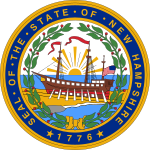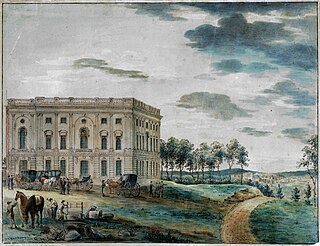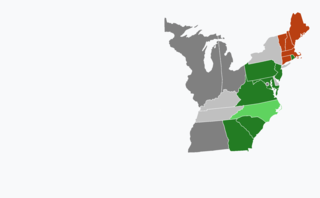A special election was held in New Hampshire's at-large congressional district on August 30, 1802, to fill a vacancy left by the resignation of Joseph Peirce (F) earlier that year.
| Elections in New Hampshire |
|---|
 |
A special election was held in New Hampshire's at-large congressional district on August 30, 1802, to fill a vacancy left by the resignation of Joseph Peirce (F) earlier that year.
| Candidate | Party | Votes [1] | Percent |
|---|---|---|---|
| Samuel Hunt | Federalist | 5,322 | 55.8% |
| Nahum Parker | Democratic-Republican | 3,912 | 41.1% |
| Others | 297 | 3.1% | |
Hunt took office on December 6, 1802 [2]

The 7th United States Congress was a meeting of the legislative branch of the United States federal government, consisting of the United States Senate and the United States House of Representatives. It met in Washington, D.C. from March 4, 1801, to March 4, 1803, during the first two years of Thomas Jefferson's presidency. The apportionment of seats in the House of Representatives was based on the 1790 United States census. Both chambers had a Democratic-Republican majority, except during the Special session of the Senate, when there was a Federalist majority in the Senate.

The 1802–03 United States House of Representatives elections were held on various dates in various states between April 26, 1802 and December 14, 1803. Each state set its own date for its elections to the House of Representatives, either before or after the first session of the 8th United States Congress convened on October 17, 1803. They occurred during President Thomas Jefferson's first term in office.
The 1802 United States Senate special election in New York was held on February 9, 1802, by the New York State Legislature to elect a U.S. Senator to represent the State of New York in the United States Senate.

The 1802–03 United States Senate elections were held on various dates in various states. As these U.S. Senate elections were prior to the ratification of the Seventeenth Amendment in 1913, senators were chosen by state legislatures. Senators were elected over a wide range of time throughout 1802 and 1803, and a seat may have been filled months late or remained vacant due to legislative deadlock. In these elections, terms were up for the senators in Class 1.

The 1802 United States House of Representatives elections in New York were held from April 27 to 29, 1802, to elect 17 U.S. Representatives to represent the State of New York in the United States House of Representatives of the 8th United States Congress.

The 1804 United States House of Representatives elections in New York were held from April 24 to 26, 1804, to elect 17 U.S. Representatives to represent the State of New York in the United States House of Representatives of the 9th United States Congress. At the same time, a vacancy was filled in the 8th United States Congress.

The 1808 United States House of Representatives elections in New York were held from April 26 to 28, 1808, to elect 17 U.S. Representatives to represent the State of New York in the United States House of Representatives of the 11th United States Congress. At the same time, a vacancy was filled in the 10th United States Congress.

Georgia gained 2 seats in reapportionment after the 1800 census. Elections were held October 4, 1802.

Maryland gained 1 seat in reapportionment after the 1800 census. Rather than increasing the number of districts, however, Maryland made the Maryland 5 a plural district with 2 seats.

North Carolina increased its apportionment from 10 to 12 seats after the 1800 census.

South Carolina increased its apportionment from 6 seats to 8 after the 1800 census.
A special election was held in Maryland's 2nd congressional district on March 2, 1802, to fill a vacancy left by the resignation of Richard Sprigg, Jr. (DR) on December 11, 1801.
A special election was held in Massachusetts's 12th congressional district on five occasions between September 25, 1801 and July 29, 1802 to fill a vacancy left by the resignation of Silas Lee (F) on August 20, 1801, prior to the beginning of the 1st Session of the 7th Congress.

A special election was held in North Carolina's 8th congressional district on October 15, 1802 to fill a vacancy left by the death of Charles Johnson (DR) on July 23, 1802.
A special election was held in South Carolina's 4th congressional district on April 12–13, 1802 to fill a vacancy resulting from the resignation of Thomas Sumter (DR) on December 15, 1801, upon being elected to the Senate.
The 1802 United States elections occurred in the middle of Democratic-Republican President Thomas Jefferson's first term, during the First Party System. Members of the 8th United States Congress were chosen in this election. Democratic-Republicans picked up several seats in both chambers of Congress, solidifying their control over the House and Senate.

The Delaware United States Senate special election for 1802 was held on January 14, 1802. Senator Henry Latimer had resigned after becoming unhappy over the tactics of his political opponents who were still bitter over the circumstances of the contested election in 1792. Samuel White defeated Archibald Alexander, who had previously failed to win gubernatorial and House elections, by 10 votes.

United States gubernatorial elections were held in 1802, in 12 states, concurrent with the House and Senate elections.